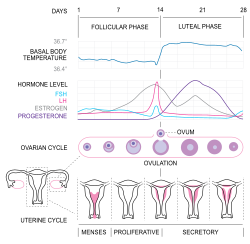Premenstrual dysphoric disorder

Editor-In-Chief: Prab R Tumpati, MD
Obesity, Sleep & Internal medicine
Founder, WikiMD Wellnesspedia &
W8MD medical weight loss NYC and sleep center NYC
| Premenstrual Dysphoric Disorder | |
|---|---|

| |
| Synonyms | N/A |
| Pronounce | N/A |
| Specialty | Psychiatry, Gynecology |
| Symptoms | Severe irritability, depression, anxiety |
| Complications | Impaired quality of life, relationship issues |
| Onset | Luteal phase of the menstrual cycle |
| Duration | Typically 1-2 weeks before menstruation |
| Types | N/A |
| Causes | Hormonal changes, serotonin dysregulation |
| Risks | Family history, stress, substance abuse |
| Diagnosis | Based on DSM-5 criteria |
| Differential diagnosis | Premenstrual syndrome, bipolar disorder, major depressive disorder |
| Prevention | N/A |
| Treatment | Antidepressants, hormonal therapy, lifestyle changes |
| Medication | SSRIs, oral contraceptives |
| Prognosis | Symptoms can be managed with treatment |
| Frequency | Affects 3-8% of menstruating women |
| Deaths | N/A |

Premenstrual Dysphoric Disorder (PMDD) is an advanced and severe form of premenstrual syndrome (PMS) that affects an estimated 5-10% of women. Predominantly characterized by profound mood disturbances, PMDD's prominent features are rooted in its cyclical nature, mainly occurring during the luteal phase of the menstrual cycle.
Clinical Presentation[edit]
The hallmark symptom of PMDD is intense irritability which emerges between ovulation and menstruation. This symptom typically dissipates within the initial days of bleeding (PMID 11571794). In addition to irritability, affected individuals may also experience heightened anxiety, pronounced anger, and episodes of depression. The severity of these symptoms distinguishes PMDD from standard PMS. Such is its impact that it significantly disrupts daily activities and interpersonal relationships, necessitating therapeutic interventions.
Classification and Perception[edit]
While the American Psychiatric Association has identified PMDD for further exploration in the DSM-IV-TR, the World Health Organization's International Classification of Diseases has not yet incorporated it as an independent disorder. Nonetheless, the Food and Drug Administration (FDA) has acknowledged PMDD as a genuine medical condition. Controversies arise with some opining that PMDD has been "marketed" to boost pharmaceutical demands. However, Swedish investigations have showcased substantial evidence pointing to its neurological underpinnings. Notably, PET (Positron emission tomography) scans revealed a profound correlation between mood symptoms and a decline in brain serotonin activity in women diagnosed with PMDD (PMID 16515859).
Etiology[edit]
The exact pathogenesis of PMDD remains elusive, but several hypotheses have emerged. A prevalent theory associates it with serotonin deficiency, a vital neurotransmitter, influenced by variations in sex hormone levels - including progesterone, estrogen, and testosterone - during the menstrual cycle's luteal phase (PMID 16515859).
Treatment[edit]
The pivotal role of serotonin in PMDD's manifestation is underscored by the efficacy of selective serotonin reuptake inhibitors (SSRIs) in addressing its mood-centric symptoms. Clinical trials have demonstrated the potency of SSRIs, especially when administered during PMDD's dysphoric phase. A case in point is fluoxetine, popularly recognized as Prozac, which has been reintroduced specifically for PMDD therapy under the brand name Sarafem. Of the myriad SSRIs scrutinized, sertraline has consistently exhibited the most significant reduction in PMDD's mood-related symptoms (PMID 10471170).
Conclusion[edit]
PMDD, though a subject of ongoing research and debate, has been acknowledged as a debilitating condition that profoundly affects the quality of life of those afflicted. While its exact cause remains a topic of exploration, current treatments, particularly SSRIs, have provided a respite to many, underscoring the importance of continuous research in this domain.
|
|
|
| Menstrual cycle | ||||||||||
|---|---|---|---|---|---|---|---|---|---|---|
|
Ad. Transform your life with W8MD's Budget GLP-1 injections from $75


W8MD offers a medical weight loss program to lose weight in Philadelphia. Our physician-supervised medical weight loss provides:
- Weight loss injections in NYC (generic and brand names):
- Zepbound / Mounjaro, Wegovy / Ozempic, Saxenda
- Most insurances accepted or discounted self-pay rates. We will obtain insurance prior authorizations if needed.
- Generic GLP1 weight loss injections from $75 for the starting dose.
- Also offer prescription weight loss medications including Phentermine, Qsymia, Diethylpropion, Contrave etc.
NYC weight loss doctor appointmentsNYC weight loss doctor appointments
Start your NYC weight loss journey today at our NYC medical weight loss and Philadelphia medical weight loss clinics.
- Call 718-946-5500 to lose weight in NYC or for medical weight loss in Philadelphia 215-676-2334.
- Tags:NYC medical weight loss, Philadelphia lose weight Zepbound NYC, Budget GLP1 weight loss injections, Wegovy Philadelphia, Wegovy NYC, Philadelphia medical weight loss, Brookly weight loss and Wegovy NYC
|
WikiMD's Wellness Encyclopedia |
| Let Food Be Thy Medicine Medicine Thy Food - Hippocrates |
Medical Disclaimer: WikiMD is not a substitute for professional medical advice. The information on WikiMD is provided as an information resource only, may be incorrect, outdated or misleading, and is not to be used or relied on for any diagnostic or treatment purposes. Please consult your health care provider before making any healthcare decisions or for guidance about a specific medical condition. WikiMD expressly disclaims responsibility, and shall have no liability, for any damages, loss, injury, or liability whatsoever suffered as a result of your reliance on the information contained in this site. By visiting this site you agree to the foregoing terms and conditions, which may from time to time be changed or supplemented by WikiMD. If you do not agree to the foregoing terms and conditions, you should not enter or use this site. See full disclaimer.
Credits:Most images are courtesy of Wikimedia commons, and templates, categories Wikipedia, licensed under CC BY SA or similar.
Translate this page: - East Asian
中文,
日本,
한국어,
South Asian
हिन्दी,
தமிழ்,
తెలుగు,
Urdu,
ಕನ್ನಡ,
Southeast Asian
Indonesian,
Vietnamese,
Thai,
မြန်မာဘာသာ,
বাংলা
European
español,
Deutsch,
français,
Greek,
português do Brasil,
polski,
română,
русский,
Nederlands,
norsk,
svenska,
suomi,
Italian
Middle Eastern & African
عربى,
Turkish,
Persian,
Hebrew,
Afrikaans,
isiZulu,
Kiswahili,
Other
Bulgarian,
Hungarian,
Czech,
Swedish,
മലയാളം,
मराठी,
ਪੰਜਾਬੀ,
ગુજરાતી,
Portuguese,
Ukrainian


